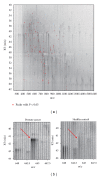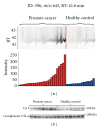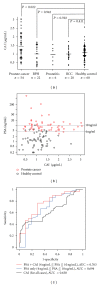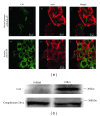Carbonic anhydrase I as a new plasma biomarker for prostate cancer
- PMID: 23213568
- PMCID: PMC3506895
- DOI: 10.5402/2012/768190
Carbonic anhydrase I as a new plasma biomarker for prostate cancer
Abstract
Serum prostate-specific antigen (PSA) levels ranging from 4 to 10 ng/mL is considered a diagnostic gray zone for detecting prostate cancer because biopsies reveal no evidence of cancer in 75% of these subjects. Our goal was to discover a new highly specific biomarker for prostate cancer by analyzing plasma proteins using a proteomic technique. Enriched plasma proteins from 25 prostate cancer patients and 15 healthy controls were analyzed using a label-free quantitative shotgun proteomics platform called 2DICAL (2-dimensional image converted analysis of liquid chromatography and mass spectrometry) and candidate biomarkers were searched. Among the 40,678 identified mass spectrum (MS) peaks, 117 peaks significantly differed between prostate cancer patients and healthy controls. Ten peaks matched carbonic anhydrase I (CAI) by tandem MS. Independent immunological assays revealed that plasma CAI levels in 54 prostate cancer patients were significantly higher than those in 60 healthy controls (P = 0.022, Mann-Whitney U test). In the PSA gray-zone group, the discrimination rate of prostate cancer patients increased by considering plasma CAI levels. CAI can potentially serve as a valuable plasma biomarker and the combination of PSA and CAI may have great advantages for diagnosing prostate cancer in patients with gray-zone PSA level.
Figures





Similar articles
-
Use of quantitative shotgun proteomics to identify fibronectin 1 as a potential plasma biomarker for clear cell carcinoma of the kidney.Cancer Biomark. 2011-2012;10(3-4):175-83. doi: 10.3233/CBM-2012-0243. Cancer Biomark. 2011. PMID: 22674303
-
Identification of adipophilin as a potential plasma biomarker for colorectal cancer using label-free quantitative mass spectrometry and protein microarray.Cancer Epidemiol Biomarkers Prev. 2011 Oct;20(10):2195-203. doi: 10.1158/1055-9965.EPI-11-0400. Epub 2011 Aug 9. Cancer Epidemiol Biomarkers Prev. 2011. PMID: 21828233 Clinical Trial.
-
Serum proteomic profiling can discriminate prostate cancer from benign prostates in men with total prostate specific antigen levels between 2.5 and 15.0 ng/ml.J Urol. 2004 Oct;172(4 Pt 1):1302-5. doi: 10.1097/01.ju.0000139572.88463.39. J Urol. 2004. PMID: 15371828 Clinical Trial.
-
Proteomics in diagnosis of prostate cancer.Pril (Makedon Akad Nauk Umet Odd Med Nauki). 2015;36(1):5-36. Pril (Makedon Akad Nauk Umet Odd Med Nauki). 2015. PMID: 26076772 Review.
-
Ten-year disease free survival after transperineal sonography-guided iodine-125 brachytherapy with or without 45-gray external beam irradiation in the treatment of patients with clinically localized, low to high Gleason grade prostate carcinoma.Cancer. 1998 Sep 1;83(5):989-1001. doi: 10.1002/(sici)1097-0142(19980901)83:5<989::aid-cncr26>3.0.co;2-q. Cancer. 1998. PMID: 9731904 Review.
Cited by
-
Spontaneous regression of tumours. Possible cross reactivity of autoantibodies against carbonic anhydrase I.J Cell Mol Med. 2023 Nov;27(22):3637-3640. doi: 10.1111/jcmm.17970. Epub 2023 Sep 29. J Cell Mol Med. 2023. PMID: 37776059 Free PMC article.
-
Construction of 2DE Patterns of Plasma Proteins: Aspect of Potential Tumor Markers.Int J Mol Sci. 2022 Sep 21;23(19):11113. doi: 10.3390/ijms231911113. Int J Mol Sci. 2022. PMID: 36232415 Free PMC article.
-
A Magnetic Bead-Based Sensor for the Quantification of Multiple Prostate Cancer Biomarkers.PLoS One. 2015 Sep 30;10(9):e0139484. doi: 10.1371/journal.pone.0139484. eCollection 2015. PLoS One. 2015. PMID: 26421725 Free PMC article.
-
PTPRQ as a potential biomarker for idiopathic normal pressure hydrocephalus.Mol Med Rep. 2017 Sep;16(3):3034-3040. doi: 10.3892/mmr.2017.7015. Epub 2017 Jul 15. Mol Med Rep. 2017. PMID: 28714010 Free PMC article.
-
Synthesis and bioactivity of several new hetaryl sulfonamides.J Enzyme Inhib Med Chem. 2017 Dec;32(1):137-145. doi: 10.1080/14756366.2016.1238367. J Enzyme Inhib Med Chem. 2017. PMID: 28100082 Free PMC article.
References
-
- Jemal A, Siegel R, Ward E, Hao Y, Xu J, Thun MJ. Cancer statistics, 2009. CA—A Cancer Journal for Clinicians. 2009;59(4):225–249. - PubMed
-
- Catalona WJ, Smith DS, Ratliff TL, Basler JW. Detection of organ-confined prostate cancer is increased through prostate- specific antigen-based screening. JAMA. 1993;270(8):948–954. - PubMed
-
- Pannek J, Partin AW. Prostate-specific antigen: what’s new in 1997. Oncology. 1997;11(9):1273–1278. - PubMed
-
- Loeb S, Gashti SN, Catalona WJ. Exclusion of inflammation in the differential diagnosis of an elevated prostate-specific antigen (PSA) Urologic Oncology. 2009;27(1):64–66. - PubMed
-
- Catalona WJ, Richie JP, Ahmann FR, et al. Comparison of digital rectal examination and serum prostate specific antigen in the early detection of prostate cancer: Results of a multicenter clinical trial of 6,630 men. Journal of Urology. 1994;151(5):1283–1290. - PubMed
LinkOut - more resources
Full Text Sources
Research Materials
Miscellaneous
